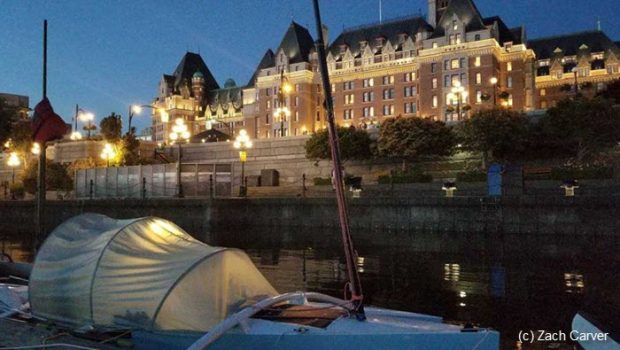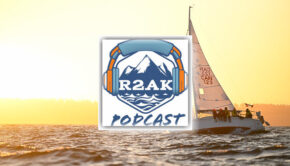Race to Alaska: The Eve of Everything
Published on June 16th, 2018
Victoria, BC (June 16, 2018) – It’s 10 pm, and if you didn’t know better you’d think it was getting quiet. The street performers of Victoria’s Inner Harbor packed up hours ago, and shadows are filling in the last corners vacated by the sun’s high sky retreat. On a typical day the the next nine or so hours would be the near-exclusive territory of of arm-in-arm couples, sleeping homeless, and the occasional stumble-drunks who have even odds of belonging to either of those categories.
But on the night before the Race to Alaska’s Victoria start, the hundred-plus souls staring into the last eve before their romp north are divided into those lying awake in anticipation, and those who find themselves at either end of an LED light; staring into the glow of their screen, nervously reconfirming that the weather predicted now is exactly what was predicted an hour ago, or headlamp-deep into a final repack—one last check to make sure everything is in its proper place.
It’s a day-and-a-half since the last teams cleared customs and we closed the books on Stage 1. For those who made it, the trip to Victoria could have been worse, has been worse. With 40 miles of big water that opens to the Pacific, and a race clock that doesn’t stop because of weather, Stage 1’s of years past have been a boat-bashing slugfest, knocking teams into the ropes, sending them to the locker room to hang up their headgear before the main event even gets started. On average, a dozen or so teams that start the 40 mile qualifier in Port Townsend never make Victoria—nearly a third of the fleet.
Last year, Stage 1 was as much of a mean-spirited short- con as it was a qualifier; Eight hours of flat calm awarded victory to a rowboat and handed calamity to most everyone else. The most vulnerable were lured 15-miles offshore before for a head-on collision with a wind wall that built from 0 to a violent 50 in less than twenty minutes. This scattered the smallest and the slowest back across the border or into the rescuing arms of the Canadian Coast Guard. There were maydays, collisions, capsizes. It was pucker factor four in the Command Bunker, we can only guess what it was like for the teams caught in the maelstrom.
They say the sea is never the same twice, and with its reasonable winds, this year’s opening act on June 14 was less washing machine and more like the couch of a disapproving therapist. Boats weren’t smashed as much as they were asked leading questions until their answers aligned with their truth. “Why do you think you’re not ready?,” “What would happen if you waited until next year?”
Before this session timed out, Team PT Watercraft greased the start in front the Northwest Maritime Center and never looked back—ringing-in the R2AK new year in Victoria with a near-record time of four hours and nine minutes. While Team Sail Like a Girl led the the rest of the parade into the inner harbor, other teams were looking at Stage 1’s saltwater Rorschach test and making the hard call to put their R2AK back on the shelf for at least another year.
Team Extreme Sobriety put his prone paddleboard back into the truck after good sense and injuries returned; Team Hotwater declared the starting line their finish line; Team Waterworld Impending started, lost a prop, fouled a line, then hit the beach to try to finish off two months of work in the next 24 hours. Mark swallowed hard, then walked away from a five dollar bet he didn’t know about and packed it in. We were down a fiver but proud of his prudence. Live to fight another day.
The day’s breakthrough moment came when Team Fly Baby Fly read the signs and called it. It wasn’t for a lack of last-minute effort—the seeds of the retreat were planted well before the race, but came into full bloom after adding water. It started with a high-concept proa that hadn’t been sailed more than once, ever. That the original owner died is both a non-sequitur and a post hoc “I told you so” from the universe. That it was a surprise his car could only do 40 through Wyoming while towing the trailer seems more akin to the kind of detail that gains importance the closer-to-the-bone a campaign gets.
The snowball effect was 20+ extra hours of driving from Florida meant two days less to prepare the boat, meant hiring more people to get the boat rigged, meant the test sail was the trip from the marina to the starting line. Less sleep to get the boat there, less time there to get it ready, no time to sail it even once before slipping across the start line with his sail at half staff. In the end Christian pulled out early and called for a tug before he drug anchor—all within sight of the lights of Victoria. Getting assistance at that moment was the right call, but it also meant Team Fly Baby Fly’s exit from the rest of the race. This is stage one, and rules are rules.
Which brings us to today, dockside in Victoria’s Inner Harbor, the liminal space where the checklist-of-now gives way to the certain unknowns of the adventure to be. Victoria, with its R2AK race fans on pilgrimage and tourist indulgences ranging from horse-drawn carriages to maple-flavored fudge shops, is a kind of middle space between the foreign familiar and the reality of an ambiguous future; a purgatory for the prepared, a race against the clock for those teams still trying to make a good impression on whatever god they pray to.
For all of the praying and preparation, the near infinite decisions that took them from “R2AK, yes!” to whatever is left of tonight’s sleep, the window is closing on theoretical. There’s a unique gravity to this moment; the start of tomorrow’s 710 mile journey is the end of the one that got them here, and with every tick of the clock and honk of the bagpipes (seriously, it’s like every hour in this town) there’s a waning chance to nervously optimize, revise, re-analyze, obsess and prepare one last time.
When the sun reaches its tomorrow zenith and we launch the teams down the docks and into the north, with every decision that follows teams will build their R2AK; one decision at a time replaces possibility and “what if’s” are replaced by “what is.”
But that’s tomorrow. At 10pm tonight, the day before cast off, with each checked box of a checklist and restless toss of a sleeping bag, the world of the inner harbor exists in a fleeting state of suspended animation; whatever is coming, this is the eve of everything.
Race details – Tracker – Facebook – Instagram
Background:
Race to Alaska, now in its 4th year, begins with 47 teams stepping forward for the adventure of a lifetime. No motor, no support, through wild frontier. Entrants will soon learn if they have the physical endurance, saltwater know-how, and bulldog tenacity to navigate the 750 cold water miles from Port Townsend, Washington to Ketchikan, Alaska. Full report.
Source: R2K







 We’ll keep your information safe.
We’ll keep your information safe.